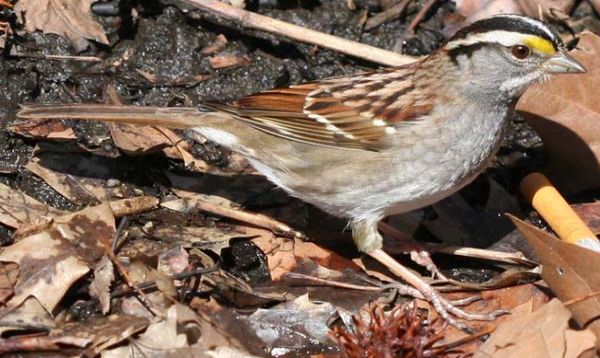Mexico City, Mexico - At last: Something GOOD about smoking! In what is both a display of ingenuity and also a troubling sign of how humansí carelessness can affect the habits of wildlife, finches and sparrows in Mexico are using cigarette butts they pick up off the street to ward off parasites from their nests and keep the baby birds warm.
Although cigarette butts are widely reviled as an urban nuisance, birds in Mexico City see them as a boon. On the grounds outside of the National University of Mexico, scientists observed birds "routinely pulling apart cigarette butts to obtain the filters."
Noting that the birds used the filters in building their nests, a team of researchers, led by Constantino Macias Garcia at the National Autonomous University, monitored 57 nests and discovered that the tally of bugs declined as the number of smoked butts in each nest increased. Indeed, the birds are using the repellent properties of the nicotine and other chemicals in the cigarette butts as pest control for their nests!
The finch nests had from none to 48 used butts in their nests and had an average of ten. The sparrow nests contained an average of eight and could have between none and 38.
 |
Garcia and his team found that "smoked" cigarettes were more effective in deterring parasites than the clean ones, and when researchers offered the birds a choice of smoked and non-smoked butts, they chose the smoked ones. The the birds can tell the difference between them by the smell and those who used larger numbers of butts had significantly fewer mites.
Nicotine had long been used in some pest repellents for crops and in controlling poultry parasites until 2008 when the EPA effectively banned them because nicotine was considered too toxic. Nicotine was also used as a treatment for intestinal parasites during the 19th century - an early edition of the United States Air Force Survival Handbook noted that, in extreme cases, eating a single cigarette can be used as a field remedy for intestinal parasites.
The behavior by the birds is an intriguing example of how they adapt to an urban environment, as the cellulose from the cigarettes also helps in insulating the birdsí nests. In non-urban settings, some birds line their nests with aromatic plants, which are thought to have antiparasitic properties or to stimulate the nestlings' immune system.
But while the Mexico City birds may be protecting their young from pests, there are certainly side effects from their choice of materials. Since eggs are rather porous, the potential health risks for cigarette butt insulation on developing embryos or adult birds are currently unknown.
The researchers hold that its observations are "consistent with the view that urbanization imposes new challenges on birds that are dealt with using adaptations evolved elsewhere." Itís been found that sparrows have to raise the volume of their tweets to be heard in cities due to noise pollution. In Mexico City, in an effort to protect their eggs and chicks, finches and sparrows could be exposing them to something like second-hand smoke - making the nests less safe than intended.


